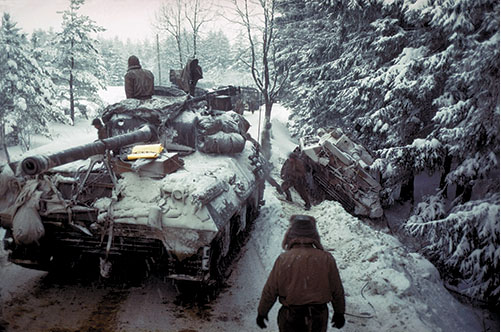
On The Liberation Trilogy
AT THE CONCLUSION of The Liberation Trilogy, his monumental three-volume narrative history of the American army in the European theater of World War II, prize-winning historian and author Rick Atkinson reflects on the challenges and rewards of covering that conflict, and turns his attention to the history of a much older conflict: the American Revolutionary War.
From the outset, did you plan the size of this history?
The narrative was conceived as a trilogy, and the finished product is pretty much how I envisioned it in 1998: Africa, Italy, Western Europe, with a story line largely built on the emergence of the U.S. military as a power capable of liberating Europe (with lots of Allied help, obviously). I didn’t know it would total 750,000 words, but I knew it was the greatest story of the 20th century.
What did you learn from volume I to volume III?
I was learning historiography as I was researching An Army at Dawn. I also had to learn the nuances of archival research since I’d done very little of it. Because the North African campaign was relatively small it had a human scale that was reassuring. And of course I found characters who would be with me for years: Eisenhower, Montgomery, Alexander, Patton, Bradley, and Rommel.
What were your most revelatory sources?
That’s hard to say because I drew on such a huge array of sources. The mystery of the next unopened archival box is what propels researchers beyond the tedium and solitude of the task. The combat interviews conducted by Army historians in the field, often just days or weeks after a particular action, are very revealing; they’re at the National Archives. There are also “Hospital Interviews” in the National Archives, conducted with wounded soldiers recuperating in England, and many of those are terrific. I returned repeatedly to places like the Hoover Institution archive, the British National Archive in Kew, the Imperial War Museum, and the Liddell Hart Centre for Military Archives in London. I was at the U.S. Army’s Military History Institute, in Carlisle, Pa., 69 times, usually for two or three days per visit. The papers of Cornelius Ryan, now very well preserved at Ohio University, and John Toland, at the Library of Congress, have many flecks of gold from the extensive interviews they conducted. Some unit archives have marvelous material, like the Iowa Gold Star Museum for the 34th Infantry Division, the 45th Division Museum, and the First Division Museum.
Were there subjects about which you could not find adequate information?
Sure. The narrative historian is constantly looking to drill down deeper on everything. Trying to understand motivation and ulterior motive is always hard when even the personality involved may not understand himself.
Who was the most remarkable character you encountered?
That’s like asking which of your children is your favorite. There are men I’ve traveled with for almost 15 years, and they’ve been marvelous companions: Lucian Truscott, Jr., Ted Roosevelt, Jr., Ernie Pyle, Alan Moorehead, George S. Patton, H. Kent Hewitt. And Dwight Eisenhower, for whom my admiration has only increased over time.
What was the most useful thing that you learned from writing these books?
Something that I understood intellectually at the beginning is something I now understand on the most visceral level: that the most enduring legacy of the Second World War is suffering.
Some people say that your Liberation Trilogy coverage of the European Theater is so thorough, detailed and wise that there is little left now to write about. Your response?
Thank you, but that’s nonsense. All truly great events are bottomless. There will always be more to write on World War II.
What is your next project?
I decided to leave World War II behind when I finished the trilogy. I’ve had a lifelong fascination with the American Revolution, and I’m now deeply engaged in researching that. I started out proposing a single volume, but the more I studied the narrative architecture of the Revolution as a battle history, the more it seemed to break into a trilogy. That’s what I’m doing.

.jpg)



